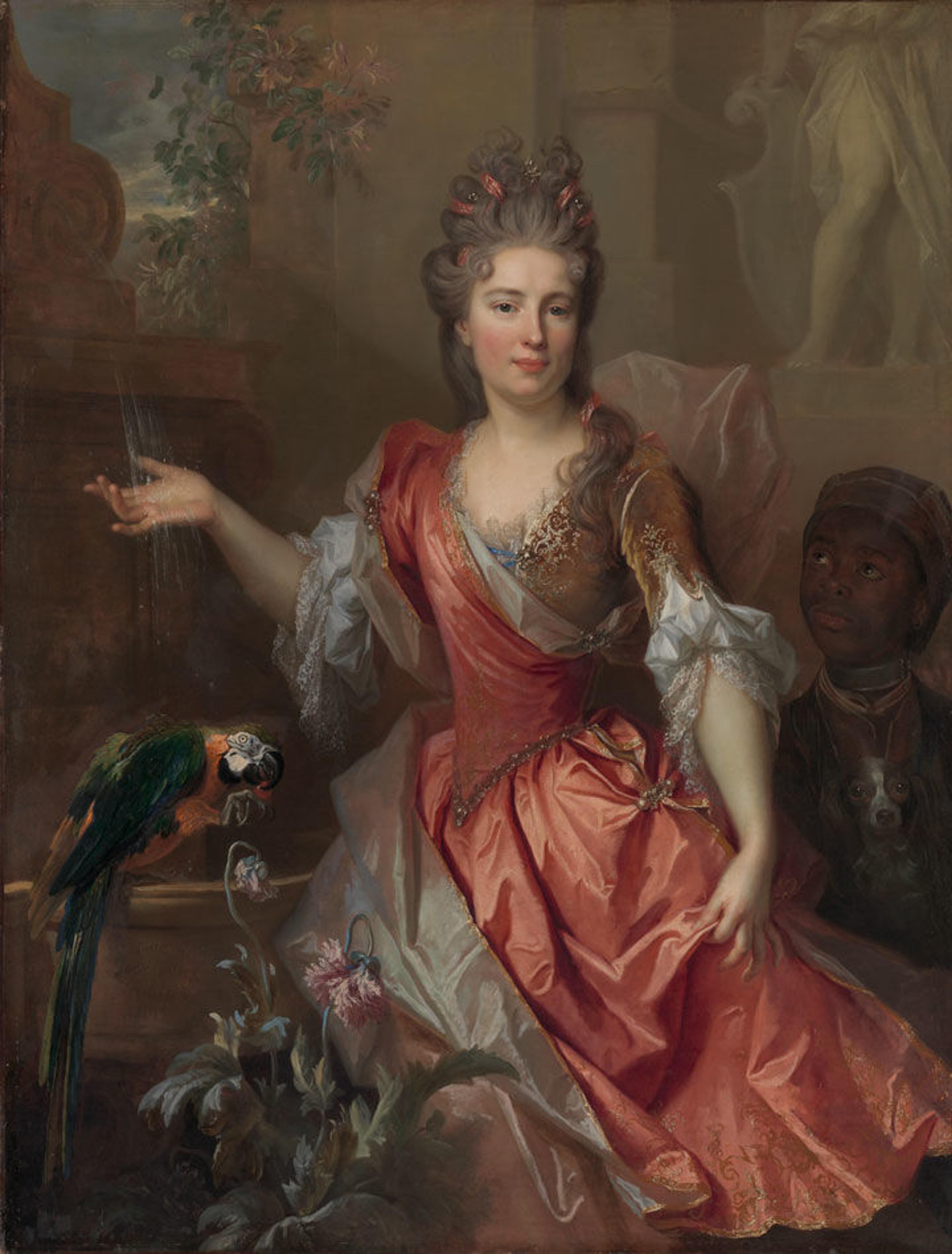Finding Context for a 17th-Century Enslaved Servant in a Painting by Largillierre

Nicolas de Largillierre (French, 1656–1746). Portrait of a Woman, Possibly Madame Claude Lambert de Thorigny (Marie Marguerite Bontemps, 1668–1701), and an Enslaved Servant, 1696. Oil on canvas; 55 x 42 in. (139.7 x 106.7 cm). The Metropolitan Museum of Art, New York, Rogers Fund, 1903 (03.37.2)
«The Met owns roughly 150 18th-century French paintings, a small collection that nevertheless includes important examples of the work of Watteau, Boucher, Greuze, Fragonard, and Jacques Louis David, among others. The earliest picture in the group under consideration, which was actually painted four years before the turn of the century, in 1696, is a fine portrait from the middle period of Nicolas de Largillierre (1656–1746). The painting depicts an uncertainly identified female sitter, possibly Madame Claude Lambert de Thorigny, accompanied by an enslaved servant boy who, until recently, had attracted little notice. The young African drew my attention as I continue to prepare a catalogue of these 18th-century French paintings, and here I hope to place him in a slightly wider historical and art-historical context than the catalogue entry will permit.»
The displacement of significant numbers of West Africans to the plantations of the French Caribbean islands dates to the third quarter of the 17th century, when sugar cane replaced tobacco as the principal crop. As the demand for sugar rapidly increased, an abundance of cheap manual labor was immediately required to cultivate and process sugar cane. France played a significant role in the slave trade only after the acquisition of Saint-Domingue (now Haiti) in 1664, when Louis XIV's minister, Jean Baptiste Colbert, established the short-lived Compagnie des Indes Occidentales.
The 1685 Code Noir, or Black Code, defined the terms of enslavement in all French territories until 1794, when the revolutionary government abolished slavery in its colonies. Poorly documented at first because many of the early voyages were clandestine, the French slave trade in the last third of the 17th century seems to have involved roughly 10,000 to 20,000 persons.
Historians have argued that there were no slaves at all in France itself, at least not in the 400 years after Louis X published a proclamation, in 1315, that was understood to mean that an enslaved person would be free once they set foot in his kingdom. Although a further decree was enacted in 1691, neither pronouncement was strictly or consistently enforced. Extrapolating from an estimate that there were 4,000 to 5,000 slaves in France in the 18th century, the number entering the country in the previous 50 years would likely have been only a few hundred. Most came, or were sent, to the motherland as personal servants of French owners of property in the Caribbean.
A few 17th-century European portraits include slaves. On the evidence of these paintings, the enslaved or formerly enslaved were men, women, and children—the majority of them young and almost all of African descent. The principal sitters for these portraits were Dutch, English, German, Italian, and French, and the artists include Anthony van Dyck (1599–1641) and Pieter Nason (1612–1688/90), as well as Pierre Mignard (1612–1695), Philippe Vignon (1638–1701), and Pierre Gobert (1662–1744).
A double portrait with an enslaved servant by Philippe Vignon at Versailles is perhaps the closest to The Met's Largillierre painting in both style and content. The slaves are presumably shown because they were the personal servants of the monarchs, aristocrats, or private persons of enormous means who were depicted. The principal sitter is generally in three-quarter- or full-length, formally dressed, and either wearing or surrounded by trappings of wealth—especially pearls and other jewelry, exotic birds and flowers, and imported porcelains. Several of the slaves wear silver or gold collars and most are dressed in lavish improvised costumes, often with turbans.
Left: Detail view of 03.37.2, showing the enslaved servant

Largillierre's portrait presents the boy in half-length holding a dog. He wears a uniform comprising a modest brown cap and coat trimmed with white piping and a hinged silver collar. His presence may offer slight support to the proposal that the woman he serves is indeed the tremendously wealthy Madame Claude Lambert de Thorigny, as only a very rich or very highly placed individual (she was both) would then have owned a slave.
The forthcoming catalogue will also include two 18th-century French genre scenes that depict enslaved Africans: Carle Vanloo's oil sketch The Hunt Breakfast of 1737, in which a turbaned adult male pours wine for a party of aristocrats enjoying an al fresco meal at the conclusion of a hunt; and Pierre Louis Dumesnil the Younger's Card Players in a Drawing Room, from the 1750s, which portrays an African youth in a plumed turban and livery coat, apparently a domestic, adding logs to a wood-burning fire in an elegant salon.
There are several portraits by Largillierre that include enslaved Africans. While their role in 18th-century European painting is wider, the total number of works in which they are depicted is still small. An expanding body of literature on related subjects neither mentions nor illustrates any of the three French paintings at The Met, which should be added to the corpus, as the subject is worthy of much closer examination and analysis.
Katharine Baetjer
Katharine Baetjer is a curator emerita in the Department of European Paintings.